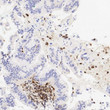| Host: | Mouse |
| Applications: | IHC-P |
| Reactivity: | Human |
| Note: | STRICTLY FOR FURTHER SCIENTIFIC RESEARCH USE ONLY (RUO). MUST NOT TO BE USED IN DIAGNOSTIC OR THERAPEUTIC APPLICATIONS. |
| Short Description : | Mouse monoclonal antibody anti-SMAD4 (1-552 aa) is suitable for use in Immunohistochemistry research applications. |
| Clonality : | Monoclonal |
| Clone ID : | B‐8 |
| Conjugation: | Unconjugated |
| Isotype: | IgG1/Kappa |
| Formulation: | Tris-HCI buffer containing stabilizing protein (BSA) and <0.1% ProClin |
| Purification: | Affinity purified |
| Dilution Range: | 1:50‐100 |
| Storage Instruction: | Store at 2‐8°C for up to 24 months. Predilute: Ready to use, no reconstitution necessary. Concentrate: Use dilution range and appropriate lab‐standardized diluent. Stability after dilution: 7 days at 24°C, 3 months at 2‐8°C, 6months at ‐20°C. |
| Gene Symbol: | SMAD4 |
| Gene ID: | 4089 |
| Uniprot ID: | SMAD4_HUMAN |
| Immunogen Region: | 1-552 aa |
| Specificity: | Positive control: Pancreatic adenocarcinoma |
| Immunogen: | Amino acid 1-552 representing full length SMAD4 of human origin |
| Post Translational Modifications | Phosphorylated by PDPK1. Monoubiquitinated on Lys-519 by E3 ubiquitin-protein ligase TRIM33. Monoubiquitination hampers its ability to form a stable complex with activated SMAD2/3 resulting in inhibition of TGF-beta/BMP signaling cascade. Deubiquitination by USP9X restores its competence to mediate TGF-beta signaling. |
| Function | In muscle physiology, plays a central role in the balance between atrophy and hypertrophy. When recruited by MSTN, promotes atrophy response via phosphorylated SMAD2/4. MSTN decrease causes SMAD4 release and subsequent recruitment by the BMP pathway to promote hypertrophy via phosphorylated SMAD1/5/8. Acts synergistically with SMAD1 and YY1 in bone morphogenetic protein (BMP)-mediated cardiac-specific gene expression. Binds to SMAD binding elements (SBEs) (5'-GTCT/AGAC-3') within BMP response element (BMPRE) of cardiac activating regions. Common SMAD (co-SMAD) is the coactivator and mediator of signal transduction by TGF-beta (transforming growth factor). Component of the heterotrimeric SMAD2/SMAD3-SMAD4 complex that forms in the nucleus and is required for the TGF-mediated signaling. Promotes binding of the SMAD2/SMAD4/FAST-1 complex to DNA and provides an activation function required for SMAD1 or SMAD2 to stimulate transcription. Component of the multimeric SMAD3/SMAD4/JUN/FOS complex which forms at the AP1 promoter site.required for synergistic transcriptional activity in response to TGF-beta. May act as a tumor suppressor. Positively regulates PDPK1 kinase activity by stimulating its dissociation from the 14-3-3 protein YWHAQ which acts as a negative regulator. |
| Protein Name | Mothers Against Decapentaplegic Homolog 4Mad Homolog 4Mothers Against Dpp Homolog 4Deletion Target In Pancreatic Carcinoma 4Smad Family Member 4Smad 4Smad4Hsmad4 |
| Database Links | Reactome: R-HSA-1181150Reactome: R-HSA-1502540Reactome: R-HSA-201451Reactome: R-HSA-2173789Reactome: R-HSA-2173795Reactome: R-HSA-2173796Reactome: R-HSA-3311021Reactome: R-HSA-3315487Reactome: R-HSA-452723Reactome: R-HSA-5689880Reactome: R-HSA-8941326Reactome: R-HSA-8941855Reactome: R-HSA-8952158Reactome: R-HSA-9615017Reactome: R-HSA-9617828Reactome: R-HSA-9733709Reactome: R-HSA-9735871Reactome: R-HSA-9754189Reactome: R-HSA-9823730Reactome: R-HSA-9839394Reactome: R-HSA-9844594 |
| Cellular Localisation | CytoplasmNucleusCytoplasmic In The Absence Of LigandMigrates To The Nucleus When Complexed With R-SmadPdpk1 Prevents Its Nuclear Translocation In Response To Tgf-Beta |
| Alternative Antibody Names | Anti-Mothers Against Decapentaplegic Homolog 4 antibodyAnti-Mad Homolog 4 antibodyAnti-Mothers Against Dpp Homolog 4 antibodyAnti-Deletion Target In Pancreatic Carcinoma 4 antibodyAnti-Smad Family Member 4 antibodyAnti-Smad 4 antibodyAnti-Smad4 antibodyAnti-Hsmad4 antibodyAnti-SMAD4 antibodyAnti-DPC4 antibodyAnti-MADH4 antibody |
Information sourced from Uniprot.org









